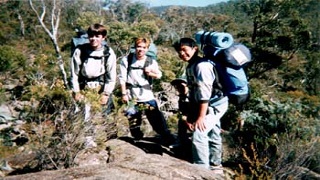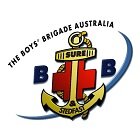CLOTHING

The careful selection of clothing and equipment is vital to your comfort and enjoyment during expeditions.
Personal clothing
Changing weather conditions makes the selection of clothing different. The solution lies wearing layers of clothing, adding or removing layers according to the weather and the amount of physical exertion being undertaken. Insulation is provided by the air trapped between the fibres of the cloth and between the layers of garments. Therefore two light jumpers provide more warmth than one jumper twice as heavy.
Footwear
Shoes should be light with soles thick enough to prevent sharp stones being felt and to absorb the pounding associated with bushwalking. New shoes need breaking-in before the hike.
Socks
Socks have to cushion the feet, absorb perspiration and provide insulation.
Underwear
Cotton underwear is the better choice. Use thermal underwear if conditions are cold.
Shirts
A polo type shirt with a collar to shield the neck from the sun. In colder conditions long sleeved flannelette. In hot conditions wear a long sleeved cotton shirt with a collar.
Trousers
Wear loose, cotton army-type pants. No Denim jeans – they are cut too tight, give little protection in wind and rain, become heavy when wet and take a long time to dry.
Headgear
A wide brim hat in the warmer months. In the cold months a wool or synthetic ?beanie?.
Wet weather clothing
A light waterproof jacket to protect against the elements. The jacket must be large enough to accommodate all the clothing you are likely to wear underneath and long enough to come well down over the hips. A hood, adjustable cuffs and a waist draw-cord will provide maximum control of air circulation.
INDIVIDUAL EQUIPMENT
Expedition packs
Your pack should be large enough to hold all your equipment and be around 65 litre capacity. A tough cordura or canvas is suitable and you should try the pack on fully loaded paying particular attention to the waist belt, shoulder straps and harness adjustability. The shoulder straps should be wide and well padded. To take some of the weight off your shoulders a well-padded adjustable hip belt is essential. Most modern packs have adjustable back lengths and are ergonomically designed.
Sleeping bags
There are two type of bags. One with a synthetic fibre filling which although bulkier and heavier than down bags are cheaper and more effective when wet. An inner cotton bag should be used to keep the bag clean. An inner bag can also be used in hot weather, sleeping in it on top of your sleeping bag.
Sleeping mats
Use a closed cell foam sleeping mat for comfort and warmer. These are much ligter than air matteresses.
Water
Each member of the party should carry their own water and between one and four litres will be needed depending on local conditions.
In-camp gear
A plastic mug, a steel or plastic plate and cutlery are needed by each individual and toilet gear should include soap and towel, toothbrush and toilet paper. All members of the party must carry a supply of rubbish bags.
GROUP EQUIPMENT
Tents
There are dozens of lightweight tents available for the bushwalker to choose from and they come in all shapes and sizes. The tents used on expeditions usually hold two or three persons and the load is shared between the occupants. It is usual to have a breathable nylon or cotton inner with a waterproof nylon fly and a slightly heavier, waterproof nylon floor. If a borrowed tent is to be used on an expedition always pitch it before the start of your venture to ensure that it is complete and that you know how to erect it. Always make sure you return it complete and dry.
Stoves
Modern methylated spirit stoves are by far the most popular and serve a dual function of stove and cooking set. They are light and compact to carry and not too expensive. They are simple and clean to use, stable and not unduly affected by the wind. NOTE: Methylated spirit burns with an invisible flame in sunlight and care must be taken to ensure that the flame is completely extinguished and the burner cooled before refuelling. Liquid fuel should always be carried in a metal bottle with a secure screw top.
FOOD AND COOKING
Normally too much thought is given to achieving variety in the menu instead of paying more attention to the need to maintain an adequate intake of liquids, especially in hot weather. Considerably more energy than usual will be expended during a camping expedition, and so more foods will need to be eaten.
Planning menus for bushwalking expeditions
When planning a menu a balance between amount of food taken and the weight of the food. If too little food is taken then the group will go hungry and the efficiency of the group may be impaired. The prime need is to pack as much energy into the smallest possible weight and volume. This is usually achieved by increasing the amount of carbohydrates and fats and by using dehydrated, freeze-dried and canned food. Supermarkets carry an endless variety of dehydrated foods and freeze dried meals so if there is a plentiful supply of water there is no need to carry the extra weight of canned food. The packaging of such products is good, they are quick to prepare and usually only require the addition of water. Only carry the foods that you like and enjoy and keep all meals uncomplicated and simple to prepare, meals such as soups, stews, casseroles and pasta dishes are ideal. Always carry more tea, coffee, milk and sugar than you think you will need. Fruit flavoured drink powders and cordials are also useful.
Breakfast
Most bushwalkers begin the day with a substantial breakfast. Others prefer to do without washing up greasy pans and prefer cereals or muesli that only requires the addition of hot or cold milk followed by biscuits or bread and jam.
Lunch
Lunches do not usually play an important part in most bushwalkers dietary routine and a little and often is the rule. Cheese and biscuits or biscuits with some spread such as jam or peanut butter are popular as are nuts and dried fruit supplemented with chocolate or sweets. These are a concentrated form of energy and can be eaten on the move. Others prefer sandwiches and fresh fruit.
Dinner
The evening meal is usually the main meal of the day and even when limited to one stove and two or three pans it is possible with a little practice to prepare a hot, filling three course meal in a very short time. A typical meal might consist of a soup, stew, casserole or pasta dish followed by dessert hot or cold or cheese with biscuits and coffee. A visit to the local supermarket will reveal a great variety of dehydrated meats, soy bean, potato, peas and other vegetables, pre-cooked rice, noodles and various pastas and instant soups. There are whips and mousses that require the addition of cold water or milk, and preparations that only require hot milk to turn them into nourishing desserts. NOTE: Plan your menu ahead, experiment with different foods and try them out at home.
Preparing a meal
When the tent has been pitched and you are ready to prepare your meal, lay out all the ingredients and allocate the pans in which they are to be cooked. Some prefer to cook a course, eat it while it is hot and then prepare the next course. Others prepare the whole meal and then eat it. Whichever you choose it is essential to economise on the use of fuel and this can be done by planning the order in which the food is cooked and eaten. After the preparation of the main course water can be boiled for washing up and for coffee. After the meal the experienced camper will wash up, tidy up, and pack away gear, which will not be needed during the night.
WHAT TO BRING
Knife, Fork, Spoon, Plastic Plates, Cup, Billy, Cooking Utensils
BRING FOOD FOR:
Saturday Lunch – premade sandwiches, small fruit boxes, oranges, apples Saturday Tea – Sausages, small potatoes in foil, dried vegies, 1 minute noodles Sunday Breakfast – Cereal, UHT milk, Eggs & Bacon, bread, butter, jam General – fruit, biscuits, Muesli Bars, snack foods, marshmallows.
PRINCIPLES OF MINIMUM IMPACT CAMPING
With the rise in popularity of outdoor recreation has come an increasing risk of damage to the natural environment. Fortunately along with the increasing number of walkers a new bushwalking ethic has also developed. The minimum impact philosophy is now being widely adopted for of bushwalking and expeditioning in Australia.
Campsites
Look for low impact campsites, sandy or hard surfaces are better than boggy or vegetated areas. Where possible camp at an existing campsite rather than creating a new one. If a campsite does not exist camp at least 50 metres away from watercourses and the track. Spend only one or two nights at such a campsite. With modern camping equipment you should leave a campsite looking as if you have never been there.
Fireplaces
Use only existing and safe fireplaces and remember that compared to campfires fuel stoves are faster, cleaner and a lot easier to use in wet weather. If you need to use a fire for cooking or warmth use an existing fireplace. Collect only deadwood and keep the fire small. NOTE: Be aware of fire bans and restrictions and how they relate to the use of stoves.
Washing-up
Remember detergents, tooth paste and soap even biodegradable types harm fish and water life. Wash 50 metres away from lakes and streams and scatter the wash water so that it will filter through the soil before returning to the stream. Avoid putting food scraps into streams or lakes. Do not wash-up directly under the tap of a rainwater tank. Under no circumstances wash in stock troughs on pastoral properties.
Rubbish disposal
Pack to minimise rubbish and avoid carrying potential rubbish such as bottles, cans and excess wrappings. Do not burn, bash or bury rubbish as this disturbs the soil and the rubbish is likely to be dug up and scattered by animals. Carry out all your rubbish. NOTE: If you come across other people?s rubbish pick that up too.
Toilets
Where there is a toilet please use it; in areas without toilets bury your faecal waste. Choose a spot at least 100 metres away from campsites and watercourses and dig a hole 15 cm deep within the soil?s organic layer (a hand trowel is useful for this) and bury all faecal waste.

